From Palm Sunday through the celebration of Easter, Catholics around the world celebrated the holiest of weeks united knowing that the celebration of the life, death and resurrection of Our Lord Jesus Christ is the central tenant of the Faith.
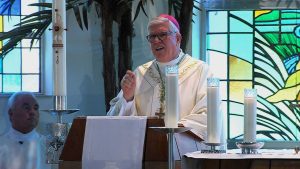
There is no denying that Holy Week 2020 was unprecedented, with the coronavirus pandemic forcing the suspension gatherings for Mass across the globe. However, thanks to modern technology, the faithful were able to stay connected to the Church from afar.
The live streaming of Holy Week services – Palm Sunday, Holy Thursday, Good Friday, Easter Vigil and Easter – from parishes to the faithful on their home computer or television was the form of presence this year.
Bishop Frank J. Dewane, who celebrated the Triduum liturgies from Epiphany Cathedral, said the temporary closure of churches is a bitter affliction that all feel deeply.
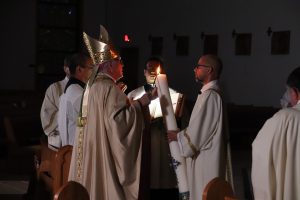 “I am painfully aware that this causes you, good Catholics, difficulty as you are troubled and hurt by the loss of the Eucharist and the other Sacraments, the consolation of those Sacraments in your life,” Bishop Dewane said “Our churches are closed, but yet I think we have to think of something else. Christ isn’t quarantined from any of us. Indeed, the Gospel is not in chains. The Word of the Lord, it is out there. It is alive” Bishop Dewane said. “In prayer and in Faith we are people of the Word, the Word of God, the Word made flesh in Jesus Christ. With both of these together, whether its online or from a distance, nothing can stand in our way.”
“I am painfully aware that this causes you, good Catholics, difficulty as you are troubled and hurt by the loss of the Eucharist and the other Sacraments, the consolation of those Sacraments in your life,” Bishop Dewane said “Our churches are closed, but yet I think we have to think of something else. Christ isn’t quarantined from any of us. Indeed, the Gospel is not in chains. The Word of the Lord, it is out there. It is alive” Bishop Dewane said. “In prayer and in Faith we are people of the Word, the Word of God, the Word made flesh in Jesus Christ. With both of these together, whether its online or from a distance, nothing can stand in our way.”
Images of Pope Francis celebrating Mass in an empty St. Peters Basilica, or perhaps it was a priest standing behind the altar with no congregation present, did not diminish the significance of the liturgies. In fact, by tuning in to these celebrations, the faithful of Holy Mother Church were united in a way like never before. Remotely yes, but with a renewed appreciation for the Mass and the power of Holy Week that many may have taken for granted.
“Thank you for the beautiful Mass. The Church is empty,” one person noted on social media after watching Mass on Palm Sunday streamed live from Epiphany Cathedral in Venice.
 While the gathering for Mass had been suspended since mid-March, Palm Sunday, a day marking the triumphant entrance of Christ into Jerusalem, with its traditional distribution of palms and uplifting liturgy, as well as the reading of the Passion of Christ, assist in putting the faithful in the right frame of mind for the significant events of Holy Week.
While the gathering for Mass had been suspended since mid-March, Palm Sunday, a day marking the triumphant entrance of Christ into Jerusalem, with its traditional distribution of palms and uplifting liturgy, as well as the reading of the Passion of Christ, assist in putting the faithful in the right frame of mind for the significant events of Holy Week.
The physical separation of the faithful from the Church, changed the way one celebrated Holy Week, a week that brings comfort to many as the symbolism and traditions have been celebrated unchanged for centuries.
Parishes encouraged the faithful to proudly display palms – readily found in Florida – or other greenery, either on the doors or windows of their homes. The most imaginative created elaborate palm fans or large palm crosses for display, while others stood by the traditional placing of a palm frond behind a cross in their home or on the door knocker.
As Holy Week progressed, the faithful were comforted by seeing images from the Triduum (Holy Thursday Mass of the Lord’s Supper, Good Friday of the Lord’s Passion, and the Easter Vigil) as well as the joyous celebration of Easter, the pinnacle of the Church year.
While each liturgy went on as usual, there were some differences that were necessary in light of the ongoing threat of the pandemic and need for social distancing.
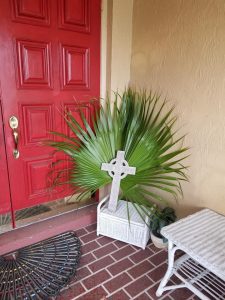
On Holy Thursday, which celebrates the institution of the Eucharist as the true Body and Blood of Jesus Christ and the institution of the Sacrament of the Priesthood, some things seemed different. For example, omitted because of the pandemic, and optional every year, was the washing of the feet by the Holy Father, Bishops and priests. In addition, following the liturgy, the Blessed Sacrament is traditionally taken to a place of repose, usually with a procession and time for Eucharistic Adoration, as the altar is stripped bare and the tabernacle emptied. Instead, with no congregation present and social distancing needed, the Blessed Sacrament was returned to the tabernacle and no Adoration took place.
On Good Friday, the most notable change was that there was no veneration of the cross, a time when the faithful would come forward to either kneel, touch, or kiss a cross with the corpus. At Epiphany Cathedral, Bishop Dewane and the concelebrating priests for the liturgy, did venerate the cross from a kneeler placed before the cross in front of the altar. The faithful, watching from the safety of their home, were in fact encouraged to venerate a cross at home, or even the cross on a rosary when no cross was present. This symbolic gesture is a show of gratitude to Christ for enduring suffering and death for the forgiveness of our sins.
 The Easter Vigil, a Mass held after sunset on Saturday, April 11, 2020, is one of the most powerful liturgies of the year. The celebration is to start in darkness, usually with the Easter fire lit and the Easter Candle brought forward. This year, the Easter Candle was lit and there was no Easter fire. This needed change removed the opportunity for the congregation to each have lit candles, providing a soft glow inside the church. In addition, the church was not darkened for the first part of the liturgy, when a series of readings, beginning with Genesis, were read.
The Easter Vigil, a Mass held after sunset on Saturday, April 11, 2020, is one of the most powerful liturgies of the year. The celebration is to start in darkness, usually with the Easter fire lit and the Easter Candle brought forward. This year, the Easter Candle was lit and there was no Easter fire. This needed change removed the opportunity for the congregation to each have lit candles, providing a soft glow inside the church. In addition, the church was not darkened for the first part of the liturgy, when a series of readings, beginning with Genesis, were read.
The portion of the liturgy unable to take place this year was when catechumens and candidates, those entering into full Communion with the Church, receive the Sacraments of Baptism, Confirmation and First Holy Communion. A new date for the opportunity for the entry into the Church for catechumens and candidates has not been determined.
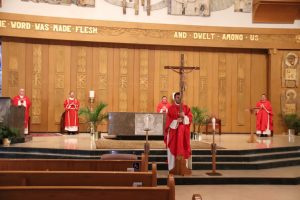 The rest of the Easter Vigil and the Easter Sunday liturgies were unaltered. The Renewal of Baptismal Promises was made at both but from afar for those watching at home.
The rest of the Easter Vigil and the Easter Sunday liturgies were unaltered. The Renewal of Baptismal Promises was made at both but from afar for those watching at home.
Bishop Dewane remarked during the televised Mass on Easter, how “this Holy Day is the basis of our Faith. This year we celebrated the Resurrection differently… and maybe this was the Easter Season that changed how each grows to believe and view the Resurrection. May this renewed belief and Faith continue to grow from this experience as we go forward from Easter into the Easter Season.”
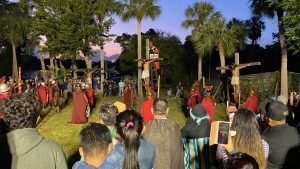 The practice began as pious pilgrims traced the Lord’s path through Jerusalem on the Via Dolorosa. As many wanted to pass along the same route as Jesus, but could not make the journey to Jerusalem, a practice developed that eventually took the form of the 14 stations currently found in almost every church throughout the world.
The practice began as pious pilgrims traced the Lord’s path through Jerusalem on the Via Dolorosa. As many wanted to pass along the same route as Jesus, but could not make the journey to Jerusalem, a practice developed that eventually took the form of the 14 stations currently found in almost every church throughout the world.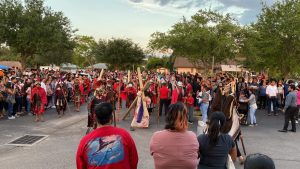 This devotional prayer is recited throughout the year and tends to concentrate on the Fridays during the Lenten Season. The Stations can also be done in the form of a reenactment, or Living Stations, on Good Friday. Pope Francis took part in the annual Living Stations of the Cross at the Roman Colosseum on Good Friday, April 15, 2022. The devotion allows the Faithful to make a spiritual pilgrimage and meditate on the Passion of Christ.
This devotional prayer is recited throughout the year and tends to concentrate on the Fridays during the Lenten Season. The Stations can also be done in the form of a reenactment, or Living Stations, on Good Friday. Pope Francis took part in the annual Living Stations of the Cross at the Roman Colosseum on Good Friday, April 15, 2022. The devotion allows the Faithful to make a spiritual pilgrimage and meditate on the Passion of Christ.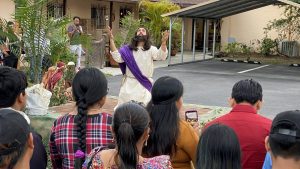 For the Faithful at Jesus the Worker Parish in Fort Myers, the annual Living Stations is something this Hispanic community takes seriously. In the parking lot and field behind the Parish Hall, stages were erected, and a reenactment of the Stations took place, complete with Jesus crowned with thorns, as well as dozens of actors dressed in centurion garb or playing key figures in the retelling of the Passion. Upwards of a thousand Faithful first watched the opening scenes before following the 14-step procession as it wound its way through the Parish parking lot, stopping along the way to relive the suffering Christ endured with a narrator recounting the Gospel readings.
For the Faithful at Jesus the Worker Parish in Fort Myers, the annual Living Stations is something this Hispanic community takes seriously. In the parking lot and field behind the Parish Hall, stages were erected, and a reenactment of the Stations took place, complete with Jesus crowned with thorns, as well as dozens of actors dressed in centurion garb or playing key figures in the retelling of the Passion. Upwards of a thousand Faithful first watched the opening scenes before following the 14-step procession as it wound its way through the Parish parking lot, stopping along the way to relive the suffering Christ endured with a narrator recounting the Gospel readings.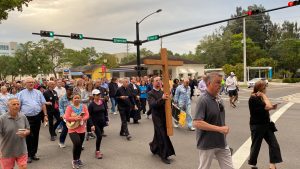
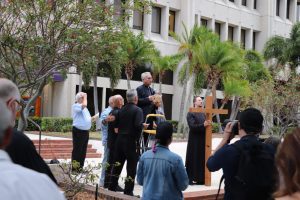
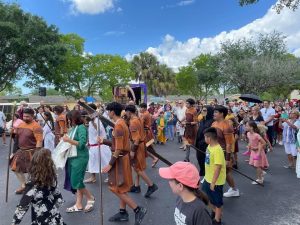

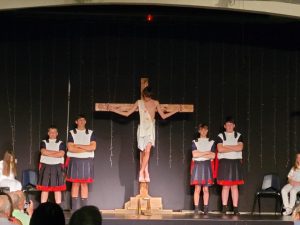





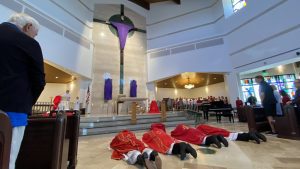 The Paschal Triduum of the Passion and Resurrection of the Lord begins with the evening Mass of the Lord’s Supper (Holy Thursday), has its center in the Easter Vigil, and closes with Vespers (Evening Prayer) of the Sunday of the Resurrection (Easter).
The Paschal Triduum of the Passion and Resurrection of the Lord begins with the evening Mass of the Lord’s Supper (Holy Thursday), has its center in the Easter Vigil, and closes with Vespers (Evening Prayer) of the Sunday of the Resurrection (Easter).
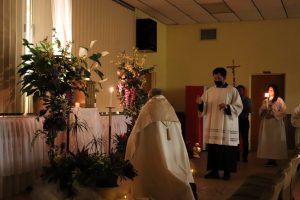 The Mass of the Lord’s Supper at St. Catherine Parish in Sebring included the commemoration when Jesus Christ established the Sacrament of Holy Communion prior to His arrest and crucifixion. It also observes His institution of the priesthood. This Liturgy included the presentation of the oils blessed and consecrated by Bishop Frank J. Dewane during the April 12 Chrism Mass, at Epiphany Cathedral in Venice, which will be used for the Sacraments in the Parish throughout the year. Later was the traditional washing of the feet, reenacting Jesus washing the feet of the Disciples. Following the Prayer after Communion, the Mass concluded with a procession to transfer the Holy Eucharist to the place of repose in the Parish Hall. This procession led out the main doors of the church and to the hall. This action left the tabernacle vacant until the Easter Vigil.
The Mass of the Lord’s Supper at St. Catherine Parish in Sebring included the commemoration when Jesus Christ established the Sacrament of Holy Communion prior to His arrest and crucifixion. It also observes His institution of the priesthood. This Liturgy included the presentation of the oils blessed and consecrated by Bishop Frank J. Dewane during the April 12 Chrism Mass, at Epiphany Cathedral in Venice, which will be used for the Sacraments in the Parish throughout the year. Later was the traditional washing of the feet, reenacting Jesus washing the feet of the Disciples. Following the Prayer after Communion, the Mass concluded with a procession to transfer the Holy Eucharist to the place of repose in the Parish Hall. This procession led out the main doors of the church and to the hall. This action left the tabernacle vacant until the Easter Vigil. On Good Friday of the Lord’s Passion, the faithful at St. John the Evangelist Parish in Naples participated in the Liturgy which included the reading of the Passion from the Gospel of John. Next was the presentation of the cross, brought forth by the priest and unveiled as the priest sang: “This is the wood of the cross, on which hung the salvation of the world,” and the congregation responded: “Come let us adore.” The faithful were then encouraged to come forward to venerate the cross. This was done by either touching, bowing, or genuflecting.
On Good Friday of the Lord’s Passion, the faithful at St. John the Evangelist Parish in Naples participated in the Liturgy which included the reading of the Passion from the Gospel of John. Next was the presentation of the cross, brought forth by the priest and unveiled as the priest sang: “This is the wood of the cross, on which hung the salvation of the world,” and the congregation responded: “Come let us adore.” The faithful were then encouraged to come forward to venerate the cross. This was done by either touching, bowing, or genuflecting.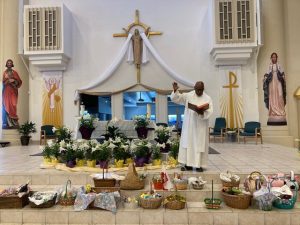 On Holy Saturday, the only Mass of the day is the Easter Vigil, which begins in darkness. However, several Parishes did host a blessing of the Easter Baskets/food. This custom traditionally blesses food to be consumed at the first meal of Easter.
On Holy Saturday, the only Mass of the day is the Easter Vigil, which begins in darkness. However, several Parishes did host a blessing of the Easter Baskets/food. This custom traditionally blesses food to be consumed at the first meal of Easter. Many Parishes also hosted fun for children which often included Easter Egg hunts.
Many Parishes also hosted fun for children which often included Easter Egg hunts.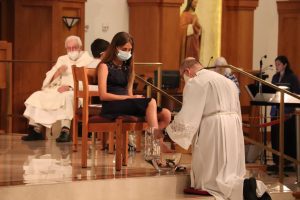 The Paschal Triduum of the Passion and Resurrection of the Lord begins with the evening Mass of the Lord’s Supper (Holy Thursday), has its center in the Easter Vigil, and closes with Vespers (Evening Prayer) of the Sunday of the Resurrection (Easter).
The Paschal Triduum of the Passion and Resurrection of the Lord begins with the evening Mass of the Lord’s Supper (Holy Thursday), has its center in the Easter Vigil, and closes with Vespers (Evening Prayer) of the Sunday of the Resurrection (Easter).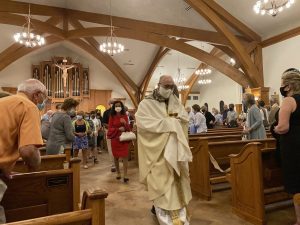

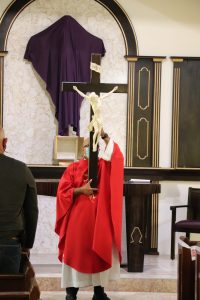 Later, was the traditional washing of the feet. A procession with the Holy Eucharist to transfer the Eucharist to the place of reposition in the Parish Hall followed the Prayer after Communion. This procession led out the main doors of the church and then around to the rear where the hall is located. Along the way were tiki torches to light the path.
Later, was the traditional washing of the feet. A procession with the Holy Eucharist to transfer the Eucharist to the place of reposition in the Parish Hall followed the Prayer after Communion. This procession led out the main doors of the church and then around to the rear where the hall is located. Along the way were tiki torches to light the path.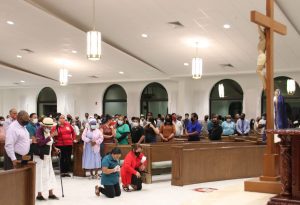
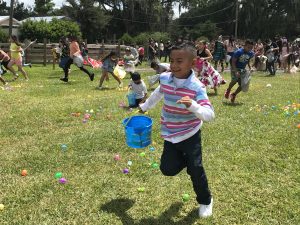

 “I am painfully aware that this causes you, good Catholics, difficulty as you are troubled and hurt by the loss of the Eucharist and the other Sacraments, the consolation of those Sacraments in your life,” Bishop Dewane said “Our churches are closed, but yet I think we have to think of something else. Christ isn’t quarantined from any of us. Indeed, the Gospel is not in chains. The Word of the Lord, it is out there. It is alive” Bishop Dewane said. “In prayer and in Faith we are people of the Word, the Word of God, the Word made flesh in Jesus Christ. With both of these together, whether its online or from a distance, nothing can stand in our way.”
“I am painfully aware that this causes you, good Catholics, difficulty as you are troubled and hurt by the loss of the Eucharist and the other Sacraments, the consolation of those Sacraments in your life,” Bishop Dewane said “Our churches are closed, but yet I think we have to think of something else. Christ isn’t quarantined from any of us. Indeed, the Gospel is not in chains. The Word of the Lord, it is out there. It is alive” Bishop Dewane said. “In prayer and in Faith we are people of the Word, the Word of God, the Word made flesh in Jesus Christ. With both of these together, whether its online or from a distance, nothing can stand in our way.” While the gathering for Mass had been suspended since mid-March, Palm Sunday, a day marking the triumphant entrance of Christ into Jerusalem, with its traditional distribution of palms and uplifting liturgy, as well as the reading of the Passion of Christ, assist in putting the faithful in the right frame of mind for the significant events of Holy Week.
While the gathering for Mass had been suspended since mid-March, Palm Sunday, a day marking the triumphant entrance of Christ into Jerusalem, with its traditional distribution of palms and uplifting liturgy, as well as the reading of the Passion of Christ, assist in putting the faithful in the right frame of mind for the significant events of Holy Week.
 The Easter Vigil, a Mass held after sunset on Saturday, April 11, 2020, is one of the most powerful liturgies of the year. The celebration is to start in darkness, usually with the Easter fire lit and the Easter Candle brought forward. This year, the Easter Candle was lit and there was no Easter fire. This needed change removed the opportunity for the congregation to each have lit candles, providing a soft glow inside the church. In addition, the church was not darkened for the first part of the liturgy, when a series of readings, beginning with Genesis, were read.
The Easter Vigil, a Mass held after sunset on Saturday, April 11, 2020, is one of the most powerful liturgies of the year. The celebration is to start in darkness, usually with the Easter fire lit and the Easter Candle brought forward. This year, the Easter Candle was lit and there was no Easter fire. This needed change removed the opportunity for the congregation to each have lit candles, providing a soft glow inside the church. In addition, the church was not darkened for the first part of the liturgy, when a series of readings, beginning with Genesis, were read. The rest of the Easter Vigil and the Easter Sunday liturgies were unaltered. The Renewal of Baptismal Promises was made at both but from afar for those watching at home.
The rest of the Easter Vigil and the Easter Sunday liturgies were unaltered. The Renewal of Baptismal Promises was made at both but from afar for those watching at home.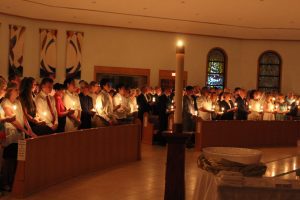
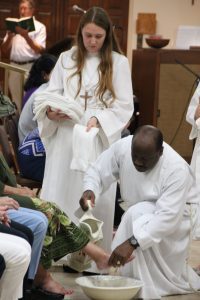
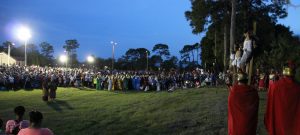 The Good Friday Liturgy, is not a Mass, but is comprised of the celebration of the Lord’s Passion, Veneration of the Cross and reception of Eucharist. All are invited to come forward for the Veneration of the Cross. Veneration of the Cross is the climax of our response to the Passion. The faithful are called to behold Christ in his great act of love and we respond with loving veneration. For Christians, veneration of one cross, with the Body of Christ on it, means loving service to the cross and taking up one’s cross and following Christ crucified. Everyone is asked to leave this liturgy in silence.
The Good Friday Liturgy, is not a Mass, but is comprised of the celebration of the Lord’s Passion, Veneration of the Cross and reception of Eucharist. All are invited to come forward for the Veneration of the Cross. Veneration of the Cross is the climax of our response to the Passion. The faithful are called to behold Christ in his great act of love and we respond with loving veneration. For Christians, veneration of one cross, with the Body of Christ on it, means loving service to the cross and taking up one’s cross and following Christ crucified. Everyone is asked to leave this liturgy in silence.